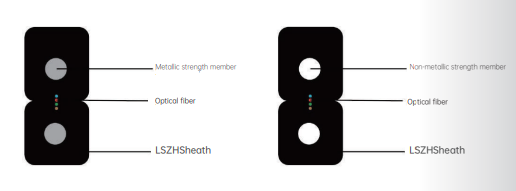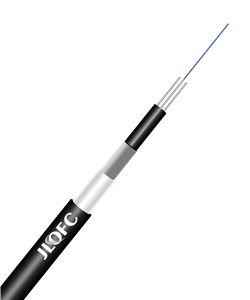Product Description For butterfly introduction of indoor optical cables used in access networks, the communication unit is placed in the center, with two parallel non-metallic strength members (FRP) placed on both sides. Finally, it is extruded with black or colored low smoke zero halogen sheath to form the cable.
Product Description For butterfly introduction of indoor optical cables used in
access networks, the communication unit is placed in the
center, with two parallel non-metallic strength members (FRP)
placed on both sides. Finally, it is extruded with black or
colored low smoke zero halogen sheath to form the cable.
Product Feature ◆ Specialized bend-resistant optical fibers provide greater
bandwidth and enhance network transmission characteristics.
◆
Two parallel FRP (Fiber Reinforced Plastic) strengthen the
cable's compression resistance and protect the optical fibers.
◆ The cable has a simple structure, lightweight, and practical.
◆ Easy stripping facilitates splicing, simplifying installation
and maintenance.
◆ Low smoke zero halogen flame-retardant sheath is
environmentally friendly.
Structural Parameters

Optical Characteristics


Structural Parameter Characteristics
Fiber Count: It usually comes in three specifications: 1 - core, 2 - core, and 4 - core, which can meet the communication needs of different users. For example, a 1 - core cable can be used for simple voice or low - speed data transmission, a 2 - core cable can be used for two - way communication or backup lines, and a 4 - core cable can provide higher bandwidth and more service - carrying capacity.
Cable Structure: GJYXCH places the optical communication unit in the center, two parallel non - metallic strength members on both sides, an additional steel wire strength member on the outside, and finally extrudes a black or colored low - smoke zero - halogen sheath to form the cable. This structural design enables the cable to have good compressive performance and strong tensile capacity.
Dimension Specifications: The common specification of GJYXCH cable is 2.0 × 5.0mm, and the low - friction type is 1.6 × 3.7mm. The small size makes the cable more flexible in laying, facilitating threading or arrangement in narrow spaces.
Strength Members: The two parallel non - metallic strength members in the center can protect the optical fiber from external extrusion. The outer steel wire strength member provides good tensile performance for the cable. The steel wire is usually phosphated steel wire or copper - clad steel wire, with a diameter of generally 0.6mm or 0.42mm. In addition, there is a self - supporting strength member with a diameter of 1.0mm or 1.2mm, made of 1*7 steel wire strand or 1.2mm single round steel wire, which is used to enhance the self - supporting capacity of the cable, enabling it to adapt to the needs of outdoor overhead laying.
Sheath: Low - smoke zero - halogen (LSZH) material is used as the sheath. This material has good flame - retardant performance, does not produce a large amount of toxic smoke when burning, and reduces harm to the human body and the environment. At the same time, the LSZH sheath also has good weather resistance and chemical corrosion resistance, and can adapt to different outdoor environments. The minimum wall thickness of the sheath is generally not less than 0.4mm, which can effectively protect the internal optical fibers and strength members.
Physical Performance Parameter Characteristics
Weight: The weight of GJYXCH cables of different specifications varies. Generally speaking, the weight of 1 - core, 2 - core, and 4 - core GJYXCH cables with the 2.0 × 5.0mm specification is 18.1kg/km, while the weight of 1 - core and 2 - core cables with the low - friction 1.6 × 3.7mm specification is 15.2kg/km. The light weight is convenient for construction personnel to carry and lay, reducing the construction difficulty and labor intensity.
Tensile Force: GJYXCH cable has good tensile performance. Its long - term tensile force is 100N, and the short - term tensile force is 200N. This means that under normal use and certain external impact, the cable can maintain structural integrity and performance stability, ensuring the normal transmission of optical signals.
Crushing Force: In practical use, the cable may be subjected to external forces such as extrusion. The long - term crushing force of GJYXCH cable is 1000N, and the short - term crushing force is 2200N. The high crushing force index enables the cable to withstand a certain degree of extrusion without affecting the performance of the internal optical fibers.
Bending Radius: The static bending radius of GJYXCH cable is 15mm, and the dynamic bending radius is 30mm. The small bending radius requirement allows the cable to adapt to various bending environments during laying, for example, when laying at corners in buildings or in curved parts of pipelines, it is not easy to cause damage to the optical fiber or increase signal attenuation due to excessive bending.
Optical Performance Parameter Characteristics
Fiber Type: It usually uses optical fibers that meet the ITU - T G.657 standard. This kind of optical fiber has good bending performance, can maintain low bending loss under a small bending radius, and is suitable for indoor and outdoor wiring environments.
Mode Field Diameter: At a wavelength of 1310nm, the mode field diameter is 8.9 ± 0.4μm. The stability of the mode field diameter is crucial to the transmission quality of optical signals. A suitable mode field diameter can ensure the efficient transmission of optical signals in the optical fiber, reducing signal distortion and loss.
Cladding Diameter: The cladding diameter is 125 ± 0.7μm, which meets relevant international standards. The precise control of the cladding diameter helps to ensure the optical and mechanical properties of the optical fiber, and ensures the connection accuracy and stability between optical fibers.
Cutoff Wavelength: The cutoff wavelength λcc ≤ 1260nm (20m cable + 2m fiber). The cutoff wavelength parameter determines the wavelength range in which the optical fiber can effectively transmit optical signals, ensuring that the optical signals can be transmitted normally in the optical fiber at a specific wavelength, avoiding signal attenuation and distortion.
Attenuation Coefficient: At a wavelength of 1310nm, the maximum attenuation coefficient is 0.34dB/km; at a wavelength of 1550nm, the maximum attenuation coefficient is 0.23dB/km. The low attenuation coefficient means that the optical signal has less energy loss when transmitted in the cable, enabling longer - distance transmission.
Bending Loss Performance: At a wavelength of 1550nm, when the bending radius is 15mm, the bending loss of 10 turns is less than 0.03dB; when the bending radius is 10mm, the bending loss of 1 turn is less than 0.1dB; when the bending radius is 7.5mm, the bending loss of 1 turn is less than 0.5dB. The good bending loss performance enables GJYXCH cable to adapt to various complex laying environments, and even in the case of large bending, it can ensure the transmission quality of optical signals.
Environmental Performance Parameter Characteristics
Temperature Range: The working temperature range of GJYXCH cable is - 40℃ to 60℃, the storage and transportation temperature range is also - 40℃ to 60℃, and the installation temperature range is - 10℃ to 50℃. The wide temperature range enables the cable to work normally under different climatic conditions, whether in the cold north or the hot south, it can maintain stable performance.
Flame Retardant Performance: Due to the use of low - smoke zero - halogen sheath material, GJYXCH cable has good flame retardant performance and can pass the single vertical burning test. This characteristic enables the cable to effectively prevent the spread of fire when used indoors, improving the safety of use.
Anti - aging Performance: The LSZH sheath material has good anti - aging performance, can resist the erosion of environmental factors such as ultraviolet rays and ozone, and prolong the service life of the cable. During long - term outdoor use, the sheath of the cable is not easy to aging, crack and other phenomena, thus ensuring the stable performance of the internal optical fiber.
Waterproof Performance: Although GJYXCH cable is mainly used for outdoor overhead introduction, it also has certain waterproof performance. The sheath material and structural design can prevent moisture from invading the interior of the cable, avoid damage to the optical fiber due to moisture, and ensure the normal transmission of optical signals.
Other Performance Parameter Characteristics
Separability: GJYXCH cable has good separability, and the tearing force is 5N to 15N. This means that during the construction process, construction personnel can easily peel off the sheath of the cable, exposing the internal optical fibers and strength members, which is convenient for optical fiber splicing and connection operations.
Environmental Protection Performance: GJYXCH cable meets the RoHS (Restriction of Hazardous Substances) standard, that is, the restriction of hazardous substances directive. This indicates that the cable strictly controls the use of hazardous substances such as lead, mercury, cadmium, hexavalent chromium, polybrominated biphenyls and their ethers in the production process, is harmless to the environment and human health, and meets environmental protection requirements.
Compatibility: The cable can be matched with a variety of field connectors and can be terminated on site. This enables during the construction process, appropriate connectors can be selected according to actual needs to complete the connection of the cable conveniently and quickly, improving the construction efficiency. At the same time, good compatibility also ensures the connection stability and reliability between the cable and other communication equipment.
Application: Aerial
Note:
a.The suffix Xn in the model indicates the selected fiber type, see Yangtze Fiber Model Explanation for details.
b.The color arrangement of the loose tube and fibers can be found in the chromatogram.
c.The minimum thickness of the polyethylene sheath is 1.5mm.
d.The cable should not be stored in open-air environments for more than 6 months, otherwise the spool may be damaged.
e.This document is for reference only and cannot be used as an attachment to the contract. For detailed product information, please contact our sales staff.












